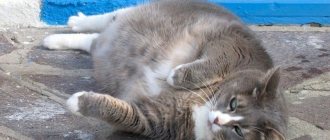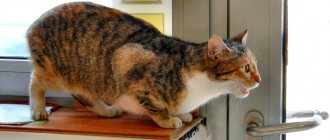If the owners are lucky enough to have a cat, then it is extremely important for its health that the pet at least once acquires kittens. There is a category of owners who prefer to decide their pet’s fate and resort to sterilization. But if a pet is still expecting a new addition, it is extremely important for owners to prepare for this event and have sufficient information on this issue.
Unlike humans, cat pregnancy has its own characteristics: you need to understand what signs to recognize pregnancy in cats - how many kittens to expect, how to prepare your pet, how long pregnancy lasts in cats, how to provide care after lambing, and much more.
Signs of pregnancy in cats
So, how to recognize that an animal is expecting offspring? The first signs may be a change in the pet’s behavior: the cat becomes very affectionate, demands increased attention, caresses and is happy to be held. Depending on how long a cat is pregnant, her taste preferences also change: during the first weeks she may eat even less than usual, but by the third week her appetite increases. Among the physiological symptoms, it should be noted the absence of another estrus, swelling of the nipples and a change in their color.
You can reliably determine how long a cat is pregnant and how many kittens a cat is carrying by having an ultrasound done in a specialized veterinary clinic. Such a study is considered quite reliable, starting from the fifteenth day of pregnancy. In addition, there is an interesting “folk” method for determining how many kittens a cat bears by number: usually pregnant cats’ nipples swell and it is believed that their number corresponds to the number of future offspring.
Keep warm
Warmth is no less important for babies. Usually their mother warms them with her warmth, and her body temperature is two degrees higher than human temperature. If kittens are weaned from their mother, you need to provide a source of heat in their den - for example, a bottle of hot water, always wrapped in several layers of natural fabric so that the babies do not get burned! They should also have the opportunity to move away from the bottle if necessary. It is better not to use electric heating pads due to their dependence on surge voltage and difficulty regulating temperature.
It is important for kittens to maintain a constant body temperature
How long is the gestation period in cats?
The main difference between the pregnancy of cats and other mammals is how many months a pregnant cat walks. When asked how many months a cat carries kittens, we can answer that a cat’s pregnancy lasts about nine weeks, that is, a couple of months. How long pregnancy lasts in cats largely depends on the breed of the pet: it has been noted that for short-haired breeds this period can be slightly shortened, and for long-haired ones, on the contrary, it can increase. In addition, how many days a cat’s pregnancy lasts is influenced by the number of kittens she carries: the greater the number, the shorter the gestation period.
If lambing does not occur after 10 weeks, you should immediately contact a veterinarian. There are several more alarm bells, when a pet needs urgent medical attention: the cat does not eat for more than a day, drinks a lot and is breathing heavily; the temperature rises above 39 degrees or drops below 38 (the exception is the day before the expected lambing, then a slight drop in temperature can be expected); opaque discharge is observed.
When is labor induction needed?
It is up to the veterinarian to decide what to do if the cat cannot give birth. Otherwise, an incorrectly determined reason for the delay in birth will lead to complications or death of the pet.
Stimulation is carried out when there is a prolonged interval between the birth of kittens (1-3 hours) or late lambing. Before inducing labor in a cat, you need to make sure that the measures taken will not harm her.
Stimulation of the uterus begins with a gentle massage of the abdomen and nipples. The administration of oxytocin is used in emergency cases, if it is established that there is no mechanical blockade. The decision to give an injection is made by the doctor, since an incorrect dose of the administered medication will cause rupture of the cervix, death of the kittens and/or the mother in labor.
Nutrition during cat pregnancy
The diet of a pregnant cat should be designed in such a way that it includes a large number of foods containing protein, namely meat dishes, dairy products, etc. If you are using food, then you should not immediately change it to another brand; it is better to choose from the same line, but specialized food for pregnant cats. Such food already contains all the necessary ingredients and microelements (proteins, calcium, etc.) needed by the mother and future kittens.
But you should not use any additional supplements or medications without consulting a veterinarian, because this can cause harm to future offspring. The amount and frequency of food intake depends on the stage of pregnancy in cats and how many kittens the cat carries in her stomach. In the first few weeks, a pregnant cat should be fed twice a day, and the portions should remain the usual for the pet.
It is important to exclude fish from the diet during this period, since its consumption interferes with the normal absorption of B vitamins.
It is better to introduce cottage cheese into your diet as a substitute, which is also rich in calcium. Three meals a day are introduced from the third week, but from the fifth week the cat itself will ask to be fed more often and more, since it is during this period that the kittens are actively growing and the expectant mother’s tummy increases significantly in size. Here it is preferable to eat small, frequent meals (5-6 times a day), but in small portions. At this stage, it is advisable to include more dairy products in the diet.
But in the last few weeks, it is better to remove meat from the list of foods to prevent poisoning from excess protein. Pet owners need to carefully ensure that the pregnant cat does not overeat and avoid obesity, as this usually leads to a difficult, long labor, because the weight of the kittens also increases. Your cat can also be given general health vitamins for pregnant cats.
Foster mother for kittens
If for some reason you have to replace a mother cat, then the main thing you need to know is that feeding and raising kittens is hard work. At the same time, it must be taken into account that no matter how much a person cares for a newborn kitten and no matter how much he loves it, the chances of the baby being born are in any case lower than if the kittens had a mother. Therefore, if it happens that the biological mother cannot take care of the babies, find them an adoptive mother. Any nursing cat, with the right approach, can accept someone else’s offspring, the main thing is to approach the matter wisely.
If the biological mother cannot take care of the babies, find them a foster home
In order to “transfer” kittens to another nursing cat who is not their mother, you need to follow a few simple steps:
- place the kittens in the room where the potential mother is - usually hungry kittens squeak pitifully and she can find them herself;
- give the babies a cat smell - you can place them in the nest while the cat is away or lead each kitten around its mother while she sleeps;
- allowing the mother to sniff the kittens - this will be the main greeting ritual;
- make sure that the mother licks each one - this will mean that she has accepted the baby into the family and he is a full-fledged member of it.
Licking is a sign that the kitten has been accepted by the cat.
There are known cases when representatives of completely different species and subspecies became mothers for cats and female cats - for example, in one of the zoos in Thailand, a tigress became a mother for piglets. True, it turned out that she herself was raised as a pig until she was 4 months old. If you didn’t manage to find a parent for the babies, then you will have to not only learn how to feed them properly, but also become a full-fledged mother, and this means efficiently performing 4 most important functions for newborn kittens:
- feed;
- warm;
- ensure hygiene and monitor health;
- teach.
Preparing for lambing
The owner can learn that the moment of lambing is approaching by the behavior of the pet: the cat intensively licks itself and begins to look for a cozy, suitable place for giving birth. For this purpose, you should prepare a clean, spacious box in advance and make a hole for a manhole on one of the walls. Clean towels or sheets are placed in the box and changed as needed. The box is covered with a lid on top to ensure optimal temperature conditions for future offspring. It is recommended to locate this structure in a quiet, dry, dark place, and keep it perfectly clean.
It also does not hurt the owners to stock up on the minimum necessary list of medications and auxiliary materials, namely:
- disinfectant (alcohol or hydrogen peroxide will do);
- clean diapers;
- scissors;
- special sterile wipes;
- brilliant green (needed when processing the umbilical cord);
- cotton threads for tying the umbilical cord;
- veterinarian contacts.
An additional list of medications can also be clarified by visiting a veterinary clinic in advance.
Immediately the moment of lambing
Depending on how the cat’s pregnancy is progressing—how many days the pet has been carrying kittens, the approach of lambing can be predicted by a number of signs, the main ones being the appearance of milk from the nipples and a slight decrease in body temperature below normal. The onset of labor is accompanied by contractions and the breaking of red-gray water, and there is an average break of about ten minutes between the birth of kittens. That is, depending on the number of kittens, the procedure itself should not take more than an hour from the moment the first kitten is born.
Usually the cat copes with childbirth on its own, but in some cases the help of the owners is necessary. For example, the umbilical cord should be cut and processed; make sure that the kittens are freed from the membrane in which they are born; turn them face down so that they begin to breathe fully on their own and excess fluid comes out of the respiratory tract. After birth, kittens usually crawl to their mother and suck milk. If this happens, then the owners have nothing to worry about and should leave the cat and kittens to rest in peace.
How to understand that labor has begun
Symptoms of impending labor appear within 1-2 hours. The owner should stay close to the animal to monitor whether the water breaks.
Harbingers (signs) that a cat will give birth soon:
- loss of appetite, cat drinks often;
- you can see how the kittens move in their stomachs;
- there is discharge from the perineum, which the cat licks;
- nipples are swollen, colostrum appears when pressed;
- rectal temperature decreased to 37 °C;
- lethargic behavior: the cat is apathetic before giving birth and does not leave the box;
- 4-6 hours before lambing, false contractions develop;
- within 1-2 hours the birth plug comes out, then the waters pour out.
Postnatal care for the cat and offspring
For the first few days after lambing, it is necessary to maintain a relatively stable temperature in the “cat house” (about 28-29 degrees). You should ensure your cat has an easily digestible diet. This can be a “light” feed five times a day, as well as an abundance of dairy products to replenish the calcium lost by the animal. Among other things, you should take care of sufficient drinking regime.
It was previously mentioned that the length of time a cat bears kittens largely depends on the breed of the animal. Many people are interested in how long pregnant British cats walk, since the breed is quite common and owners are afraid of missing the most important moment of lambing. When asked how many days a cat carries British kittens, we can answer that the duration of pregnancy in British cats is about 63-70 days. It is noteworthy that specialists in some veterinary clinics do not know that the duration of pregnancy in cats depends on the breed and, if they suspect a delay in lambing, they resort to cesarean section. That is why owners should study all the intricacies of this process themselves in order to be informed.
Another interesting question: how long do pregnant Scottish cats walk? This breed usually survives for about 62-65 days. But the record holders are considered to be Siamese cats, whose lambing most often occurs on the 58-60th day.
A cat is ready for pregnancy already at 8-9 months of life, but experts do not recommend taking your pet for mating before a year.
Owners should prepare for lambing in advance: they should monitor how many days pregnant cats walk, pay attention to the behavior of the pet and provide the necessary assistance in a timely manner directly during childbirth. If you are not sure that the assistance will be provided with high quality, it is better to agree in advance with the veterinarian about the possibility of coming. Read more about care after lambing in the article “Cat with kittens: proper care after birth.”











